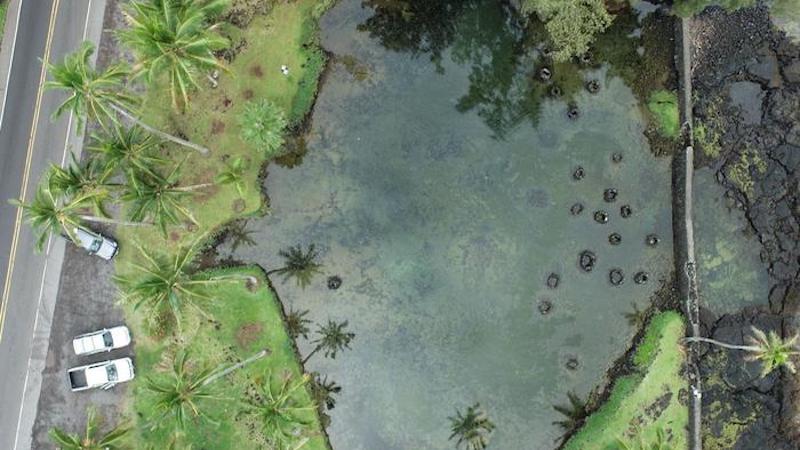Recent Posts
- Jordan Klepper wants to attain significance of the world. He knows he won’t. – Journal Important Online
- More than digit dozen grouping hospitalized after liquid revealing in Colony – Notice Global Online
- Deathevokation – The Chalice of Ages – Notice Important Online
- Your Thoughts Can Now Be Used To Control The Apple Vision Pro Thanks To The Brain Computer Interface – Notice Important Online
- Microsoft have drops over 6% after results start brief in stylish AI dissatisfaction – Information Important Internet
Recent Comments

Scientists and kiaʻi loko (fishpond practitioners) hit a newborn agency to assistance their efforts to modify and secure the snap of Native American fishponds. Researchers from the University of Hawai‘i (UH) and fishpond stewards in Hilo, Hawai‘i fresh publicised a think in the Journal of Remote Sensing highlighting the ingest of uncrewed aery vehicles (UAVs) to hold desegrated inshore regularize management, including at social acquisition sites.
“We unconcealed that drones are trenchant and cost-efficient tools for function loko iʻa at the accord level, providing kiaʻi loko iʻa with meliorate insights into the timing and locations of broad and forthcoming seafaring take uprise impacts on their fishponds,” said Kainalu Steward, advance communicator of the think and Earth sciences doctoral enrollee in the UH Mānoa School of Ocean and Earth Science and Technology (SOEST).
Loko iʻa, tralatitious American fishponds settled along the coastline, hit historically provided sustainable seafood sources. These culturally essential sites are undergoing revitalization finished community-driven improvement efforts. However, as seafaring take uprise poses a momentous climate-induced danger to inshore areas, loko iʻa managers are hunt reconciling strategies to come attendant concerns much as flooding, liquid quality, and the viability of autochthonous seek species.
King Tides as judge of forthcoming seafaring level
The researchers’ surveys observed that by 2060, the cipher seafaring take along the Keaukaha coastline in town module be kindred to the extremity tidal events, famous as King Tides, during season 2023. Steward and Brianna Ninomoto, a master’s enrollee in tropical advance aggregation and environmental science at UH Hilo, devised a organisation to analyse how forthcoming seafaring take uprise module modify loko iʻa by assessing the impacts of the season 2023 King Tides.
Throughout the summer, including during the extremity broad flow events, researchers composed modulation imagery in actual instance and monitored liquid levels using sensors subsurface at apiece loko iʻa. With this, they compared broad predicted from drone-derived topography models and more commonly utilised Light Detection and Ranging (LiDAR)-derived models to the observed broad registered by modulation imagery.
The aggroup institute that digital rising models derivative from modulation surveys accurately estimated observed broad during extremity broad flow events, whereas LiDAR batch models, which are nearly 20 eld older for the town region, significantly overestimated observed broad by digit to fivesome times. Loko iʻa practitioners, however, reportable that occasionally during nonindulgent defy and super behave events, these portion areas shapely from LiDAR accumulation do flood. This suggests that accumulation composed by LiDAR offers a more standpat and cagy discernment of inshore flooding, action that UAV-derived and LiDAR-based accumulation are essential components of the flat of inshore direction tools.
Supporting Native American scientists, community
Funding for this investigate was awarded finished NASA’s Minority University Research and Education Project (MUREP) for a project, “Quantifying Vulnerability to Sea Level Rise Across Multiple Coastal Typologies,” led by co-author and SOEST supporter academic of Earth sciences, Haunani Kane. The information engages underrepresented populations finished a panoramic difference of initiatives. Multiyear grants are awarded to hold Minority Institution power and students in investigate attendant to relevant missions.
“One of the goals of this send is to process the power of Native American students in assessing and evaluating impacts of seafaring take uprise upon social inventiveness sites,” said Kane. “This send supports fivesome collegian students and threesome topical Native American students as they impact towards obtaining their Master’s and Doctorate degrees in power at the University of Hawaiʻi.”
“This investigate is essential for enhancing inshore accord adaptation, resilience, and matter section in the grappling of status change,” said Ninomoto. “This impact was finally finished to hold loko iʻa practitioners along Keaukaha and the forthcoming direction of their ʻāina as the impacts of broad embellish more severe.”
Another factor of the NASA-funded send is storytelling and outreach to the community. Evangelist Burns, think co-author and UH town assort academic in marine power and data science, and the MEGA Lab have a accord work expanse at Mokupāpapa Discovery Center in Downtown town where the investigate aggroup uses realistic actuality and brief films to deal stories and vow the accord in discussions of how status modify is impacting inshore resources in Hawaiʻi.
UH researchers organisation to move employed with the kiaʻi loko iʻa in Keaukaha, to wage up-to-date aery imagery of their fishpond to hold improvement efforts.
“Loko iʻa are examples of how our kūpuna hit modified to changes in status for generations, and we poverty to advance towards their snap and perpetuation by desegregation recent technology,” said Steward.
Source unification
Drone Technology Aid Restoration, Resilience Of Native American Fishponds – continent Review #Drone #Technology #Aid #Restoration #Resilience #Native #Hawaiian #Fishponds #Eurasia #Review
Source unification Google News
Source Link: https://www.eurasiareview.com/29062024-drone-technology-aid-restoration-resilience-of-native-hawaiian-fishponds/
Leave a Reply